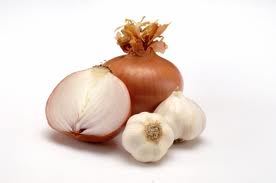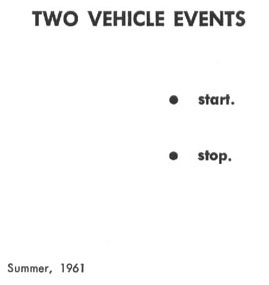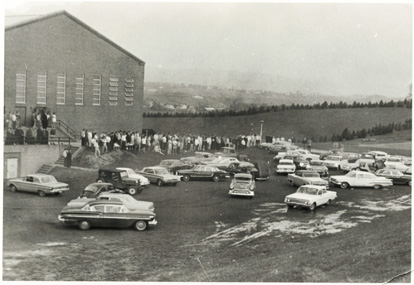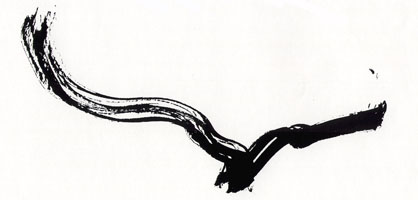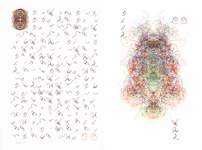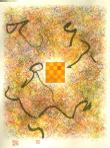main menu | site map | search | contact | home
ALGORITHMIC ART
Composing the Score for Visual Art by Roman Verostko
Written in 1994 with edits in 1996 & 1998.
Note on the algorists: This "Algorithmic Art" page existed before we established the use of the term algorist for artists who practiced algorithmic art. After the term "algorist" was introduced I inserted a brief account of the algorists on this page. (see below) Several years later I mounted an algorist web site. But I have maintained most of the information on this page as originally posted including the 1995 algorist addition. There have been some corrections and several footnotes.
Algorithmic design, Hispano-Moorish tile, 14th C, Nasrid Palace, Granada, Spain Photo RValgorithm & algorism
Algorithm is a variant of the earlier term algorism. Early usage in the English language appears variously as augrime, augryme, algorisme, algorism and variations with Latinizing influence as in algorismus. In English the term algorism appears in late 17th Century writing as algorithm which is commonly used today. The transformation to algorithm may have been influenced by classical learning since the Greek term for number is ’arithmós (’αριθμός) the root for our English term arithmetic. Origin. The term algorism most probably descended from the name of an Arabian mathematician active in Bagdad around 820 AD. This mathematician, Abu Ja'far Mohammed Ben Musa, a native of Khwarasm, surnamed al-Khowarazmi, wrote treatises on Hindu arithmetic and algebra. The title of one of his works, al-jabrawa al-maqàbala, is taken as the source for the term algebra. It is also believed that his name, al-Khowarazmi is the source for the term algorism.
What is an algorithm? An algorithm or algorism may be viewed simply as a detailed recipe for carrying out a task. The term has its origin in mathematics as the step by step procedure for solving a problem. The commonplace procedures we use for multiplying and dividing numbers are algorithms. With precise details for each step the procedures yield the same result whether executed by a computer or by a human. This is why robots are able to handle many tasks that were once done only by humans. Example: See note 1.
Many view an "algorithmic procedure" as a strictly mathematical operation. Today we are inclined to view any well defined procedure as an algorithm. A recipe for baking bread is an algorithm. Follow the recipe faithfully and you will duplicate the kind of bread made by the person who wrote the recipe.
Applications. Machines can also be programmed to follow recipes. The programmed circuitry in bread-making machine directs the machine's mechanism on precisely how to mix ingredients, knead the dough, and bake the bread. In theory it should succeed every time but there are also factors of mechanical and human error. The quality and measure of ingredients may contribute to unwanted results.
Within the past quarter century operational instructions have been imbedded in the design of many industrial and household utilities. They implement our daily use of telephones, automobiles, cameras, TV's, and radios. Our hospitals, factories, banks, and shopping centers all depend on the algorithms that control inventories, transactions, communications and security. They are ubiquitous and our mass culture would collapse without them.
Algorithmic procedures are also imbedded in the digital tools used in the arts. Use of these tools influences form in the practice of film, architecture, photography, music, printmaking, and all types of electronic sound and image. The drudgery of executing algorithms that would require immense time, or even be impossible to execute without computing power, has been handed over to the machine leaving humans more free to focus on the creative part of their work. For the artist this means improving and improvising the art-making procedure. For the algorist, work on the algorithm is work on the procedure.
History & breadth. Although the term derives from the name for a 9th century mathematician, the use of algorithms dates from prehistoric times. Study of the stone circles at Stonehenge (c. 2000 BC) reveals an algorithmic arrangement based on phases of the moon and the annual movement of the sun. While we cannot know the meanings these builders attached to the structure we are able to discern something of the "rules" for stone positions. Their alignment relates to the annual movement of the sun and the moon.
Stonehenge, c. 2000 BC, ff.
Algorithmic arrangement
Salisbury plain, England. ca. 24 ft highphoto RV
Clearly early civilizations developed procedures for counting and measuring. They also created procedures for weaving, grinding, making fire and cooking. Any of these procedures, when well defined, could be viewed as an algorithm. Indeed weaving technology played an important role in the history of computers. If we can spell out the procedure for any given task then, given all the necessary materials and skills, we should be able to carry out the task.
Architectural plans, musical scores and dance notations ( Note 2) bear one feature in common - they are all recipes for carrying out a task. From this perspective a broad range of notational systems can be viewed and studied as algorithmic procedure. From this perspective algorithmic procedures for generating artistic forms enjoy a rich and varied tradition even though we have used other terms to describe them.
Algorithms and art.
Gregorian Chant, Missal, c.1200. Detail from the Sursum Corda.
Musical scores, viewed as instructions, are algorithms for performing music.In Art History. A history of algorithms in the visual arts would be voluminous touching many phases in every culture at every turn - the Egyptian canons for drawing the human figure, the infinite geometric play in Islamic art and the role of both linear perspective and proportion in Renaissance art. In China we would find the Mustard Seed Manual and in Byzantium the conventions for icon painting. In Europe, by the Seventeenth Century we would find extremely sophisticated algorithms for plotting the dizzying perspectives imaging the passage from earth to heaven.
Even so, notational systems for the visual arts played a limited role when compared to notational systems for music. A gifted composer could compose a score for a profoundly moving musical passage that could be played hundreds of years later by a skilled virtuoso. Not so for the painter. While Leonardo could easily employ an algorithm for creating the perspective space in the Last Supper, he could not, at that time, compose an algorithm for rendering the face of Judas.
The 20th Century. A 20th Century history would find some interesting pre-algorist examples in the 1960's and 1970's. Fluxus, minimalist and conceptual artists employed various methods of procedural specification challenging traditional conceptions of art. For example, George Brecht's early works were primarily very lean instructions printed on cards; the cards, with the instructions were the art works. Occasionally he mailed an instruction to me and he came to be associated with "Mail Art" that preceded Fax Art. His cards could be a very lean, one or two word event such as "House Number". Conceptual art in its many forms preceded so called "computer art". It was not until artists gained access to computing power that they were able to compose form-generators for the investigation of form.
As computers became more accessible to artists in the 1970's and 1980's some artists began to experiment with algorithmic procedure. The new technology offered them methods of working algorithmically that were unavailable before the advent of computers. By the 1980's a number of us were working with the pen plotter, a machine with a "drawing arm". Seeing other's work at various venues we came to know each other and share ideas. Algorists like Harold Cohen, Manfred Mohr, Jean Pierre Hebert and this author had achieved mature work but we had no common identity. Each in their own way had invented algorithmic procedures for generating their art. By doing so each created their own distinctive style. Clearly style and algorithm were linked in a very important way (Note 8).
One of the concerns for educators in the early 1980's was whether we should be teaching programming in our art schools or rather wait for advances in computing power, software programs, and printing technologies. With the growth of PC computing power, refinement of raster printing technologies, and professional software for the visual artists more and more artists took up what was generally called "computer art". The unique features and form-generating capabilities for algorithmic procedure in the hands of the artist was easily lost in the widening world of "computer art". It was in this milieu that a small group of artists, including this author, introduced panels for addressing the role of "algorithms & the artist". Following one such panel at the 1995 SIGGRAPH conference it was Jean Pierre Hebert, Ken Musgrave and myself who agreed to work towards a common identity for those who practiced algorithmic art.
Within a short time we introduced our identity as "algorists" and Jean Pierre Hebert wrote an algorithm defining an "algorist" as applied to artists (for this algorithm see note 3). Within a decade this usage led us to a better understanding of the role of algorithmic procedure in shaping world culture at the turn of the Century.
For a detailed & illustrated account of the algorists see: "Who are the algorists?"

